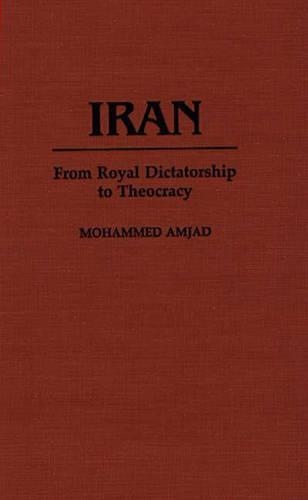
Iran: From Royal Dictatorship to Theocracy
(Hardback)
Publishing Details
Iran: From Royal Dictatorship to Theocracy
By (Author) Mohammad Amjad
Bloomsbury Publishing PLC
Praeger Publishers Inc
8th December 1989
United States
Classifications
Tertiary Education
Non Fiction
955.053
Physical Properties
Hardback
187
Width 156mm, Height 235mm
510g
Description
The unforeseen Iranian revolution stunned not only the Shah, but also observers around the globe. This element of the unexpected was based, Amjad argues, on misconceptions concerning both the Shah's power and the apparent weakenss and fragmentation of the opposition. This volume provides historical perspectives on the socioeconomic and political factors that precipitated the revolution and transformed the Iranian state from a royal dictatorship into a theocracy. Amjad analyzes the nature of the Iranian state in both pre- and post-revolutionary periods, looks at the kinds of changes in Iran during its transition to capitalism and explains the rationale behind the important part played by Islam in the revolution. Attention is paid to the Shah's role in alienating the populace at all levels of society and to how Shi'ite Islam's militant mullahs were able, in the absence of a nationwide political organization, to lead the revolution organization. Iran's populist ideology and its priorities of creating a welfare state to provide social welfare for the poor and forming an alliance between the upper and lower classes is detailed here. Discussions of theories of state, class, revolution, economic development, and also the impact of Islam in Iranian society and culture comprise the first three chapters. Socioeconomic development, class formation and the transformation of the Iranian state from 1941 to 1977 form the basis for chapters four through six. Chapters seven and eight consider the effect of domestic and international social factors on the revolution and describe how a royal dictatorship was transformed into a theocracy.
Reviews
This book provides a summary history of the political, economic, and social forces which took Iran from a traditional feudal monarchy through a brief stage of capitalism and statism to ultimate revolution and the establishment of an Islamic theocracy.-Booknotes
This splendid book offers an insight into why Iran, once assumed to have one of the most stable governments in the Middle East, crumbled so rapidly in 1979. Amjad's study attempts to answer that question by investigating the socioeconomic and political factors that led to the Iranian Revolution and to the transformation of the Iranian state from a royal dictatorship into a theocracy. The author concludes that a combination of factors such as economic mismanagement, failure of agriculture, inflation, decline in oil revenues, and political repression provided favorable conditions for the opposition to organize its forces against the Shah. Thereafter, within a few months after the overthrow of the monarchy, the religious hierarchy with the support of the traditional bourgeoisie and petit bourgeoisie was able to eliminate the liberal bourgeoisie and create a theocracy in Iran. Written in an easy-flowing narrative style, this book is finely produced and makes a valuable contribution for those interested in Iranian studies. Includes a useful glossary, an index, and an up-to-date bibliography. Recommended for senior undergraduate and graduate audiences.-Choice
"This book provides a summary history of the political, economic, and social forces which took Iran from a traditional feudal monarchy through a brief stage of capitalism and statism to ultimate revolution and the establishment of an Islamic theocracy."-Booknotes
"This splendid book offers an insight into why Iran, once assumed to have one of the most stable governments in the Middle East, crumbled so rapidly in 1979. Amjad's study attempts to answer that question by investigating the socioeconomic and political factors that led to the Iranian Revolution and to the transformation of the Iranian state from a royal dictatorship into a theocracy. The author concludes that a combination of factors such as economic mismanagement, failure of agriculture, inflation, decline in oil revenues, and political repression provided favorable conditions for the opposition to organize its forces against the Shah. Thereafter, within a few months after the overthrow of the monarchy, the religious hierarchy with the support of the traditional bourgeoisie and petit bourgeoisie was able to eliminate the liberal bourgeoisie and create a theocracy in Iran. Written in an easy-flowing narrative style, this book is finely produced and makes a valuable contribution for those interested in Iranian studies. Includes a useful glossary, an index, and an up-to-date bibliography. Recommended for senior undergraduate and graduate audiences."-Choice
Author Bio
MOHAMMAD AMJAD is Assistant Professor of Political Science and Director of the Center for Middle Eastern Studies at the College of Saint Rose, Albany, New York.
